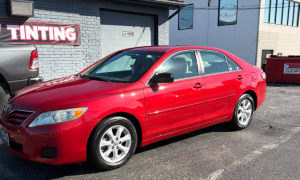If you manage a small business with one vehicle or a dozen, your fleet is more than just transportation—it’s a rolling billboard, a mobile workspace, and an investment in your brand’s image. As summer heat spikes and UV exposure accelerates wear on interiors, upgrading your fleet with professional window tinting delivers tangible benefits: lower operating costs, improved driver comfort, enhanced security, and a unified, professional look on the road. Here’s everything you need to know to get started.
What Is Fleet Tinting?
Fleet tinting applies high-performance window film to the side and rear windows of multiple vehicles in a business’s fleet—vans, trucks, SUVs, sedans—creating a consistent appearance and shared benefits across every vehicle. Unlike aftermarket one-off tint jobs, fleet tinting programs are coordinated, scheduled, and installed with the same film brand, shade level, and warranty terms to ensure uniformity and predictable performance.
Key Benefits for Small Business Owners
1. Significant Energy & Fuel Savings
Every tinted window blocks a portion of solar heat before it enters the cabin. On a delivery van or service truck that spends hours idling in the sun, reducing interior temperatures by even 10–15°F can cut air-conditioning runtime—and therefore fuel consumption—by up to 20%. Across a fleet of vehicles, those savings add up quickly on your monthly fuel bills.
2. Enhanced Driver Comfort & Productivity
Hot, glare-soaked interiors lead to driver fatigue, irritability, and slower routes. By minimizing glare and maintaining a cooler cabin, tinted windows help drivers stay focused and comfortable, reducing breaks and improving on-time performance. Happier drivers also mean better customer service and fewer complaints about sweltering vehicles.
3. Protection of Interiors & Equipment
Window tint blocks up to 99% of harmful UV rays, preventing dashboard cracking, seat fading, and deterioration of in-cab electronics. For fleets that carry expensive tools, instruments, or perishable goods, keeping the interior cooler and UV-free extends the life of your assets and reduces replacement costs.
4. Professional Branding & Uniform Appearance
Nothing says “we pay attention to detail” like a row of uniformly tinted company vehicles. Fleet tinting creates a sleek, cohesive look that reinforces your brand identity—whether you add custom vinyl logos on top of the tint or simply rely on dark, consistent window shades for a polished presentation.
5. Increased Security & Privacy
Commercial window films can include anti-shatter and safety layers that hold glass in place upon impact—deterring smash-and-grab thefts and protecting drivers and cargo. Darker tint levels also obscure expensive tools and equipment from prying eyes, reducing the risk of break-ins while parked on the street or job sites.
Types of Window Film Ideal for Fleets
| Film Type | Benefits | Best Use Case |
|---|---|---|
| Dyed Tint | Cost-effective glare reduction and UV block | Budget-conscious fleets with moderate sun exposure |
| Metalized Film | Superior heat rejection, reflective finish | Heavy-duty trucks and vehicles in extremely hot regions |
| Hybrid Ceramic | High IR/UV rejection, non-reflective, no signal interference | Urban delivery vans requiring GPS/cell clarity |
| Full Ceramic | Maximum IR/UV rejection, ultra-clear, discreet look | Premium fleets, executive transport, or extreme climates |
| Safety Film | Anti-shatter protection plus basic heat/UV control | Vehicles carrying high-value cargo or operating in high-risk areas |
How to Plan Your Fleet Tinting Program
- Assess Your Fleet’s Needs
- Vehicle types, daily routes, sun exposure patterns, and cargo sensitivity all influence the best film choice and shade level.
- Choose a Certified Installer
- Work with a professional tint installer experienced in fleet programs. They’ll handle scheduling, warranty paperwork, and ensure consistency across each vehicle.
- Standardize Film Selection
- Pick one film brand and shade for the entire fleet. Consistency simplifies ordering, installation, and future maintenance.
- Schedule Efficiently
- Coordinate installations to minimize downtime—batch vehicles by location or service schedules so your business keeps moving.
- Track Performance & ROI
- Monitor fuel savings, maintenance costs, and driver feedback. Documenting improvements helps justify the investment and plan future expansions.
Real-World Example: A Local Pest Control Fleet
- Before Tinting: Technicians complained of overheating; air-conditioning units strained under midday sun. Frequent dashboard cracks required expensive repairs.
- After Tinting with Hybrid Ceramic Film:
- Cabin temps dropped by 12–15°F
- A/C runtime decreased 18%, saving 8–10% on monthly fuel
- Dashboard and electronics remained in pristine condition over 12 months
- Drivers reported better visibility and comfort on long routes
Frequently Asked Questions
Q: How long does fleet tinting take?
A: Typically 1–2 hours per vehicle, depending on window count and film complexity. A small crew can tint multiple vehicles per day.
Q: Will tinting interfere with GPS, radio, or cell signals?
A: Not if you choose non-metallic ceramic or hybrid films. Always confirm signal performance during your consultation.
Q: What about warranty?
A: Certified installations come with factory-backed warranties (often 5–10 years) that cover peeling, bubbling, or discoloration under normal use.
Next Steps: Get Your Fleet on Board
Upgrading your fleet with professional window tinting is one of the smartest investments a small business owner can make. From measurable fuel and maintenance savings to happier drivers and stronger brand presence, the benefits extend far beyond a cooler cabin.
Ready to start? Contact Ideal Image Auto Salon for a free fleet assessment. We’ll recommend the ideal film, handle all scheduling, and keep your vehicles on the road—looking and performing their best.





